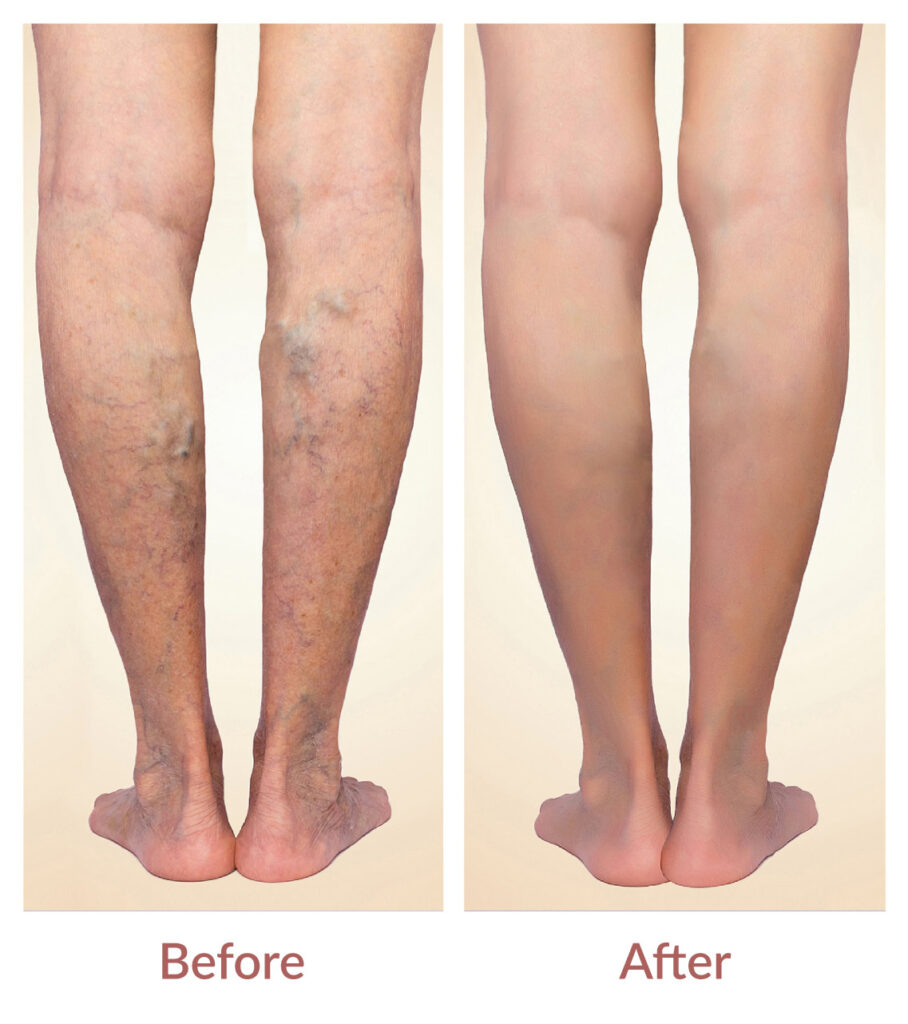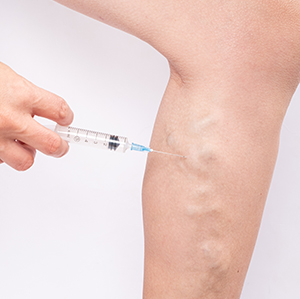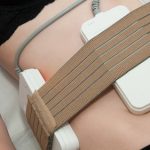SCLEROTHERAPY
What is Sclerotherapy?
Sclerotherapy is the most common treatment for improving the appearance of varicose and spider veins on the legs. It is also performed to treat symptoms caused by these conditions, such as aching, swelling and burning.
Sclerotherapy involves injecting a chemical solution directly into the varicose or spider vein. The solution causes the vein walls to swell, stick together and seal shut, stopping the flow of blood. As a result, the vein fades within a few weeks. Varicose veins are caused by weak or damaged valves in the veins. The heart pumps oxygen-rich blood to the body through the arteries. Veins then carry the blood from the body back to the heart. As your leg muscles squeeze, they push blood back to the heart from your lower body against the flow of gravity. Veins have valves that act as one-way flaps to prevent blood from flowing backward as it moves up your legs. If the valves become weak, blood can leak back into the veins and collect there, causing veins to enlarge and become varicose. Spider veins can develop from weak or damaged valves as well. They can also be caused by hormone changes, exposure to sun and injuries.
 Areas that sclerotherapy can treat?
Areas that sclerotherapy can treat?
The most common Trusted Source areas for varicose veins to develop are on your legs and feet. The affected veins may be raised, discolored, or swollen, and some may be deeper under the skin and can cause discomfort. Spider veins are smaller in size, are located closer to the surface of the skin, and can appear red, purple, or blue. Sclerotherapy for the treatment of hemorrhoids is typically used when the hemorrhoids are smaller and internal. It can also be used when the hemorrhoids bleed or when you can’t risk a surgical procedure such as a hemorrhoidectomy due to other health concerns. Depending on the size of the damaged veins, sclerotherapy can be used to treat varicose and spider veins in the following areas: thighs, calves, ankles, feet, face (frequently the sides of the nose), anus.
How will I know if I am a candidate for sclerotherapy?
Most people with varicose or spider veins can be a candidate for sclerotherapy, though the procedure is most often done on people between 30 and 60 years of age and in women. This is because these conditions become more visible as people age and tend to be less noticeable in men whose body is more covered with hair. People who are bedridden, breastfeeding, pregnant, or have given birth in the last 3 months are not candidates for the procedure. To know if you qualify for the procedure, you’ll undergo an exam by a vascular specialist, who can determine if this procedure is best for you.
How sclerotherapy works?
Depending on the severity of the condition, sclerotherapy treatment for venous problems can take about 30-45 minutes. If you’re getting treatment on your legs, your doctor may have you lie on your back with your legs elevated. Depending on how far below your skin the damaged vein is, your doctor may use an ultrasound as part of the procedure. The procedure begins with your doctor cleaning the skin around the targeted veins. With a fine needle, your doctor will inject the damaged vein with a sclerosing agent, such as: polidocanol, sodium tetradecyl sulfate, hypertonic saline solutions. The liquid or foam solution causes the walls of the injected vein to seal shut, so blood is redirected to unaffected veins. Over time, your body absorbs the damaged vein, making it less visible and uncomfortable. Based on the size of the treated vein or veins, you may need up to four treatments.
How to prepare for sclerotherapy?
First, you’ll have a consultation with a healthcare professional. They’ll help you determine if this procedure is right for you. Next, you may be advised to do the following:
Avoid certain medications, such as ibuprofen (Advil) and aspirin (Bufferin), to reduce your risk of bleeding. These medications can affect your blood’s clotting process.
Avoid applying lotion or shaving your legs before sclerotherapy to decrease irritation.
Try compression stockings. You may be required to wear them for several days after the procedure.
Notify your healthcare professional about other medical issues you have before your procedure.
Possible risks and side effects:
You may experience minor cramping, stinging, or burning in the injected vein during sclerotherapy. The procedure can also be painful, especially if the sclerosing agent leaks into surrounding tissues.
Common side effects of sclerotherapy include: bruising, stinging, swelling, skin discoloration, discomfort, raised red areas that appear around the injection sites.
All of these side effects should subside in a few days. Brown lines or spots can develop near the treatment area as well. These normally disappear within 3 to 6 months, but in some cases this side effect lasts longer or may become permanent.
More serious side effects include:
allergic reaction to the sclerosing agent, skin ulceration around the injection site, blood clots in the treated veins, discomfort around the injection site, caused by inflammation, infection in the skin.
Checking in with your healthcare professional after sclerotherapy treatment will help you manage potential side effects.
Different Types of Sclerotherapy:
There are 4 types of sclerotherapy that may be right for you, depending on your doctor’s recommendation. They are:
Liquid sclerotherapy:
This is the one we’ve been talking about from the beginning of this article. When the varicose vein treatment is done using the injection of the liquid sclerosant, the procedure is called “liquid sclerotherapy” or simply “sclerotherapy”.
Micro sclerotherapy:
For small spider veins, the sclerotherapy is done using tiny needles. This procedure is called micro sclerotherapy, and the reason is obvious: the small needle! The recovery is shorter and involves less discomfort and bruising. However, as it can be inferred, not everyone is an eligible candidate for this sort of treatment. Your doctor can determine whether you need to go with sclerotherapy or its micro version, depending on your condition.
Ultrasound sclerotherapy:
In this procedure, the doctor or dermatologist uses ultrasound to see your veins, even those which are hidden. The veins are displayed on a screen and the injection is done for the problematic vein then. Foam sclerotherapy: Instead of liquid, a foam-like solution is injected into your vein. This type of treatment is beneficial for those with larger varicose or spider veins. The sclerosant is blended with CO2 and air. Then, it’s injected and causes a more considerable contraction compared to regular injection therapy.
Cost of Sclerotherapy in Iran
Depending on the number of veins which need to be treated and how large they are, one could have sclerotherapy in Iran for the approximate price of $150 per treatment. This is while the same procedure would cost up to several hundred dollars higher in most other countries.




















